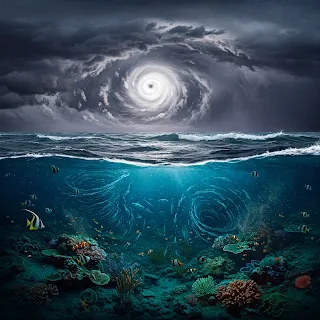Hurricanes are among the most destructive natural forces on Earth, bringing powerful winds, storm surges, and heavy rainfall. Traditionally, their effects have been studied in terms of damage to coastal areas, destruction of infrastructure, and loss of human life. However, recent research has uncovered a lesser-known impact: hurricanes significantly affect deep-sea ecosystems and the global carbon cycle. This article delves into how these massive storms alter the deep ocean, disturb marine life, and influence carbon sequestration processes.
Understanding the Deep-Sea Environment
The deep sea, defined as the part of the ocean below 200 meters (656 feet), is a largely unexplored region teeming with life. This ecosystem plays a critical role in maintaining Earth's carbon cycle by storing and processing organic material. Unlike surface waters, the deep ocean is characterized by stable temperatures, high pressure, and limited sunlight. Despite these seemingly extreme conditions, it is home to a diverse array of organisms, including corals, sponges, and deep-sea fish.
Hurricanes and Their Immediate Impact on the Ocean
Hurricanes derive their strength from warm ocean waters, fueling their rapid intensification. When these storms pass over the sea, they disrupt surface and subsurface ocean layers in several ways:
1. Mixing of Ocean Layers
Hurricanes generate powerful waves and currents that mix the upper layers of the ocean, causing warm surface waters to sink and cooler, deeper waters to rise. This process, known as upwelling, has several consequences:
It brings nutrient-rich waters to the surface, which can temporarily boost phytoplankton growth.
It disturbs the natural stratification of the ocean, affecting marine organisms that rely on stable conditions.
2. Sediment Resuspension and Seafloor Disruption
Hurricane-induced currents can stir up sediments from the ocean floor, altering habitats for deep-sea creatures. Resuspended sediments can:
Smother benthic (seafloor-dwelling) organisms, including corals and sponges.
Release trapped nutrients and pollutants back into the water column.
Affect light penetration, impacting deep-sea photosynthesis-dependent bacteria.
The Long-Term Effects of Hurricanes on Deep-Sea Ecosystems
1. Disruption of Deep-Sea Food Chains
The deep ocean relies on a steady supply of organic material sinking from surface waters, known as "marine snow." Hurricanes can alter this process in several ways:
Increased organic matter deposition: Storms cause massive phytoplankton blooms, leading to an influx of organic debris into the deep sea.
Decreased food availability: In some cases, hurricanes disperse organic material more widely, making it less accessible to deep-sea organisms.
2. Damage to Deep-Sea Coral Reefs and Habitats
Deep-sea coral reefs serve as vital habitats for marine life. Hurricanes can damage these fragile ecosystems by:
Breaking coral structures due to strong currents.
Burying reefs under layers of displaced sediment.
Reducing biodiversity by killing slow-growing species that struggle to recover.
3. Effects on Deep-Sea Carbon Sequestration
The deep ocean plays a crucial role in the global carbon cycle by storing carbon in sediments and absorbing excess CO2 from the atmosphere. Hurricanes can disrupt this process in various ways:
Enhanced carbon burial: Storm-driven upwelling increases phytoplankton activity, which can lead to greater carbon sequestration when dead organisms sink to the seafloor.
Carbon release from sediments: Resuspension of sediments may release previously trapped carbon back into the water column, potentially affecting global carbon levels.
The Connection Between Hurricanes and Climate Change
1. Stronger and More Frequent Hurricanes
Climate change is amplifying the strength and occurrence of hurricanes. Rising sea surface temperatures supply additional energy for storm development, resulting in:
Longer-lasting hurricanes.
Stronger wind speeds and greater storm surges.
More extensive oceanic disruptions, including deeper mixing and increased sediment resuspension.
2. Implications for Marine Ecosystems
As hurricanes become more intense, their impacts on deep-sea ecosystems will likely worsen. This could result in:
Permanent changes in deep-sea biodiversity.
More frequent coral reef damage.
Altered carbon sequestration patterns, affecting global climate regulation.
Scientific Research and Monitoring Efforts
1. Satellite and Ocean Sensor Networks
Scientists are using advanced technology to study the effects of hurricanes on the ocean. These include:
Satellites that track sea surface temperature, chlorophyll levels, and storm movements.
Autonomous underwater vehicles (AUVs) that measure deep-sea temperature, salinity, and nutrient levels before and after storms.
2. Deep-Sea Exploration and Data Collection
Research expeditions using remotely operated vehicles (ROVs) and deep-sea submersibles allow scientists to:
Assess damage to deep-sea coral reefs.
Collect sediment samples to study carbon sequestration.
Monitor the long-term recovery of deep-sea ecosystems.
Mitigation and Conservation Strategies
1. Protecting Deep-Sea Ecosystems
Conservation efforts are essential to safeguard marine biodiversity. Strategies include:
Establishing marine protected areas (MPAs) to limit human activities in vulnerable deep-sea regions.
Reducing bottom trawling to prevent additional disturbances to already impacted areas.
Enhancing climate policies to mitigate global warming and reduce hurricane intensification.
2. Advancing Climate Adaptation Strategies
To minimize hurricane impacts on oceanic systems, scientists and policymakers must:
Improve climate models to predict hurricane-induced ocean changes.
Develop strategies to enhance ocean carbon sequestration efficiency.
Support sustainable fishing practices that protect deep-sea habitats.
Conclusion
Hurricanes are not just surface-level threats; they profoundly impact deep-sea ecosystems and the ocean's carbon cycle. By disrupting ocean stratification, altering food chains, damaging coral reefs, and affecting carbon storage, these storms play a crucial role in shaping the underwater world. As climate change intensifies hurricane activity, understanding their deep-sea effects becomes more critical than ever. Through continued research, conservation efforts, and climate adaptation strategies, we can work towards protecting our oceans and ensuring the stability of Earth's natural systems.

No comments:
Post a Comment